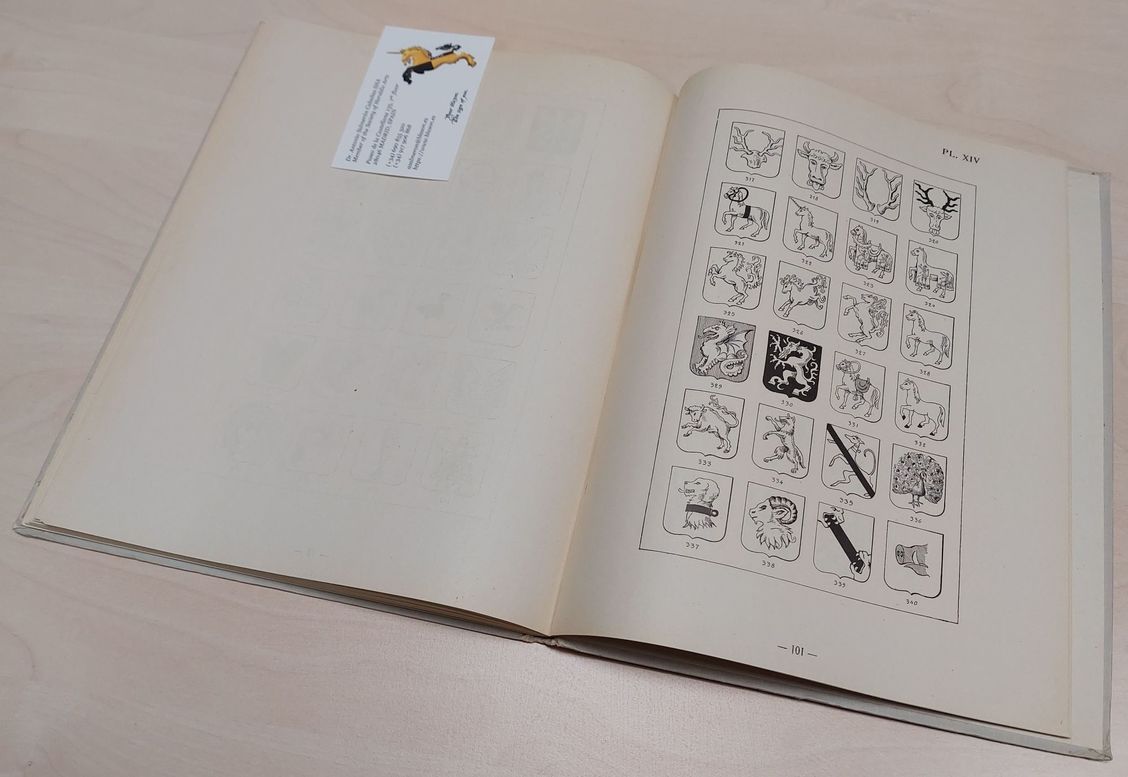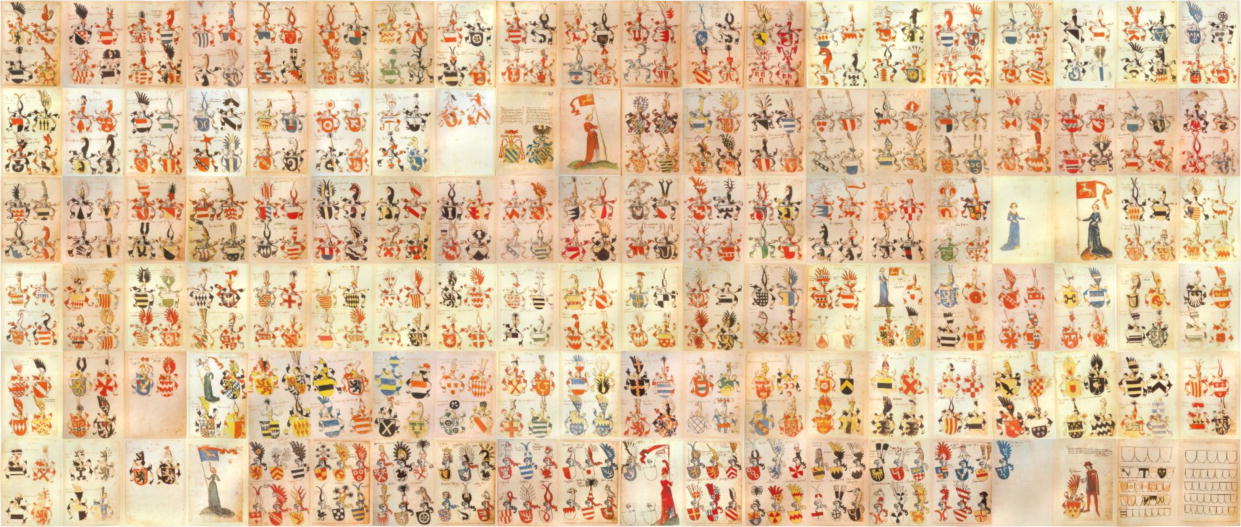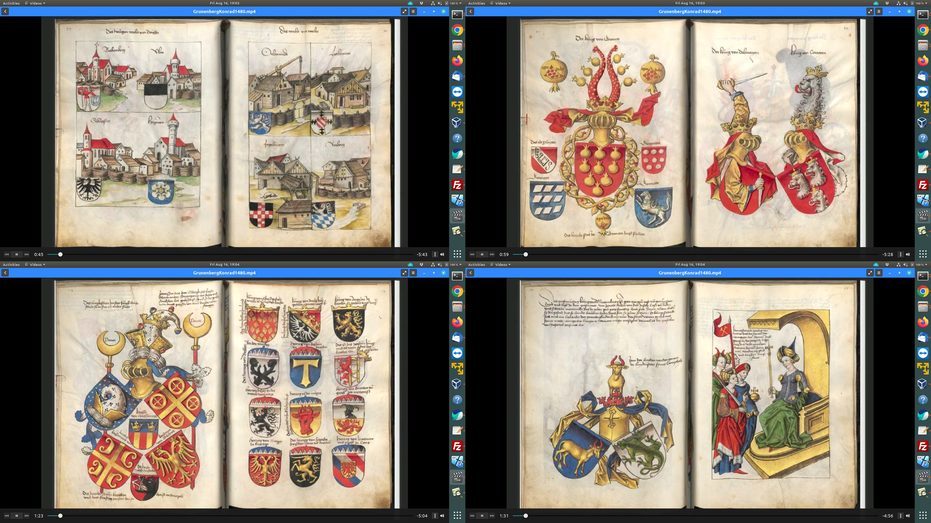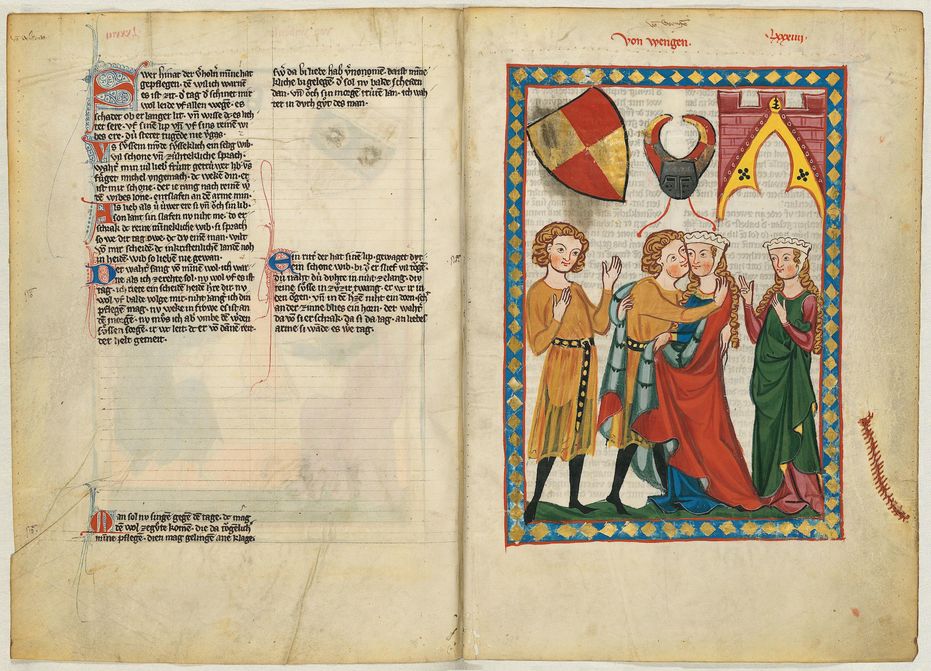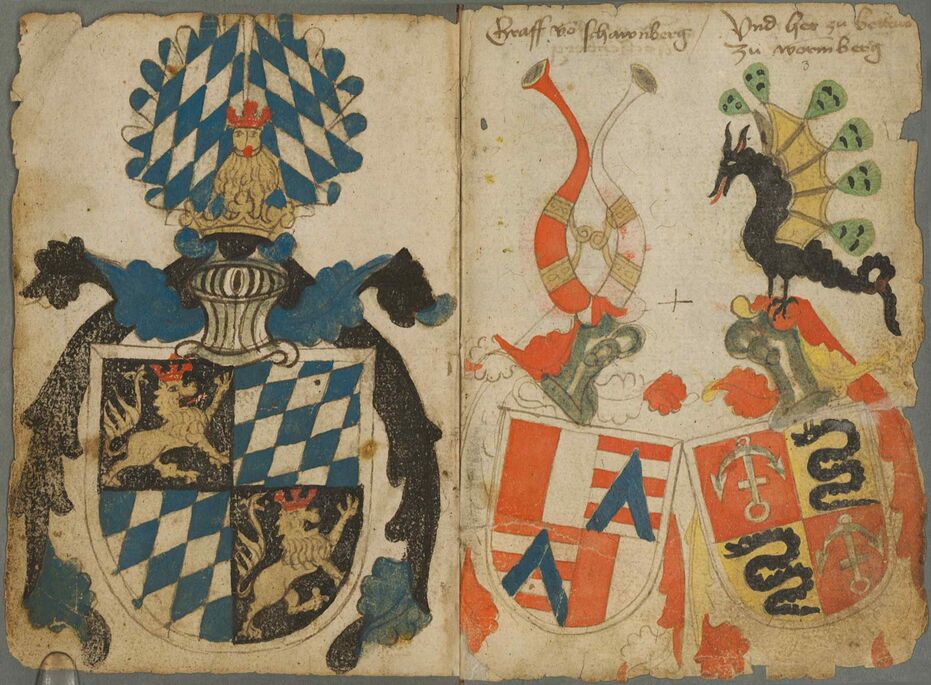German language


![Ver [Académie internationale d'héraldique; 1952] en referencias bibliográficas. Libro abierto, hojas de plata, filo de oro, guardas de gules, tapas de sable.](../css/Libro.Bibliografia.png)
Académie internationale d'héraldique; 1952
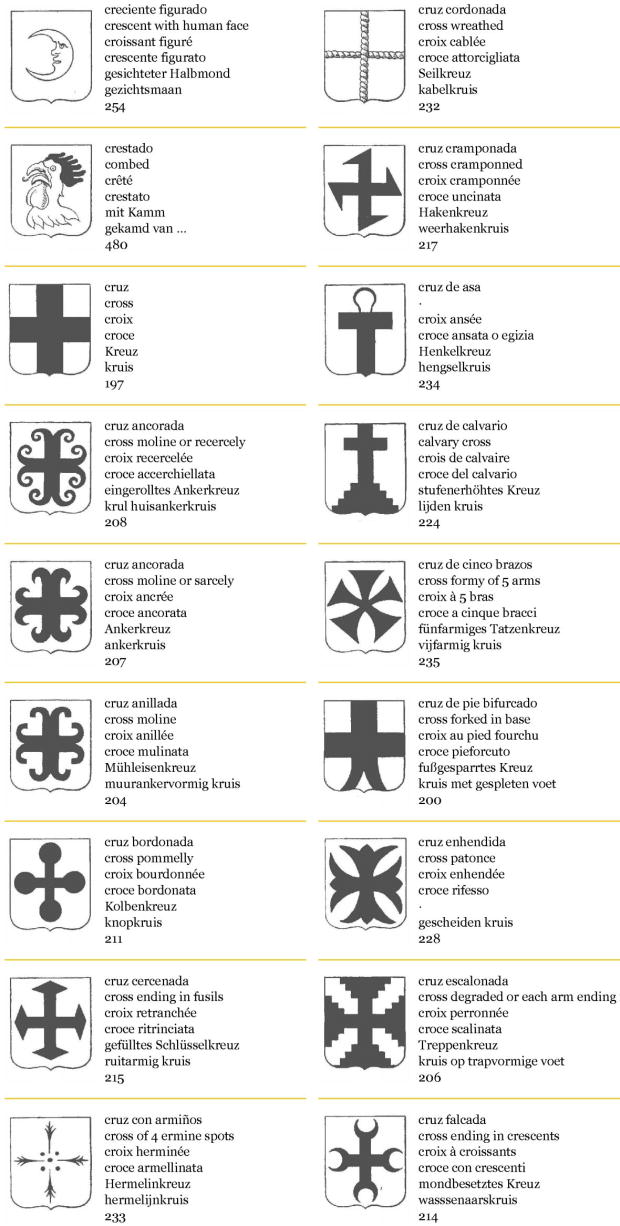
Académie internationale d'héraldique, AIH, «Vocabulaire-Atlas Héraldique en six Langues: Francais - English - Deutsch - Español - Italiano - Nederlandsch», by Gaston Stalins, Le Baron Stalins, with the collaboration of René Le Juge De Segrais, Ottfried Neubecker, Martin de Riquer y Morera, Giacomo Carlo Bascapé, and Mario Gorino-Causa, 119 pages, 530 black and white heraldic pictures, Société du Grand Armorial de France, 179 Boulevard Haussmann, París, 1952.
This book begins with the following sentence: «Heraldique - science et art - qui prit naissance en France vers la moitié du XIIe siècle, s'est propagée très rapidement dans les principaux pays européens».
The number of terms and words of the heraldry by languages is as follows:
- French language: 523 heraldic terms.
- Dutch language: 521 heraldic terms.
- German language: 519 heraldic terms.
- Spanish language: 511 heraldic terms.
- Italian language: 506 heraldic terms.
- English language: 502 heraldic terms.
The names of the authors and collaborators have been checked with [Académie internationale d'héraldique; 1999].
Its 530 heraldic illustrations correspond, according to my calculations to 509 drawings, numbered from 1 to 530. Some images contain several numbers, for example, the image that shows a coat of arms with its mantling, number 528, and its supporters, number 529, a griffin and a lion rampant, it is the same illustation, but with 2 numbers.
Bibliographical reference of century XXI.
Classification: Dictionary, French language, English language, German language, Castilian language, Italian language and Dutch language.
The names of the authors are:
- Stalins, Gaston.
- Le Juge De Segrais, René.
- Neubecker, Ottfried.
- Riquer y Morera, Martin de.
- Bascapé, Giacomo Carlo.
- Gorino-Causa, Mario.
The following articles cite this bibliographic reference:
- Ermine
- Ixai Lanzagorta Ochoa, plain tincture
- Pile issuant from the base in the Dictionary of the Spanish Language
- Sanz Lacorte, J.; 2007
- Sir Thomas Grenville II
- Val'Quirico, wreath an owl
External resource:
Internal resources: Aih1952.00.Vocabulaire.Original.pdf, Aih1952.01.Vocabulaire.Sefidn.pdf and Paper edition with a Swedish bookplate.


![Ver [Becher, C.; Gamber, O.; 1986] en referencias bibliográficas. Libro abierto, hojas de plata, filo de oro, guardas de gules, tapas de sable.](../css/Libro.Bibliografia.png)
Becher, C.; Gamber, O.; 1986
Charlotte Becher and Ortwin Gamber, «Die Wappenbücher Herzog Albrechts VI. von Österreich: Ingeram-Codex der ehem, Bibliothek Cotta, Volume 1», editado por Böhlau Verlag Wien, 178 pages, ISBN 3-205-05002-9 y 978-32-05050-02-5, Vienna, Cologne, Graz, 1986.
Dedicated exclusively to the study and analysis of the armorial [Ingeram, H.; 1459].
Bibliographical reference of century XX.
Classification: German language, Manuscript, Armorial roll and In color.
The 2 authors are Becher, Charlotte and Gamber, Ortwin.
The following article cites this bibliographic reference:
External resource:


![Ver [Grünenberg, K.; 1480] en referencias bibliográficas. Libro abierto, hojas de plata, filo de oro, guardas de gules, tapas de sable.](../css/Libro.Bibliografia.png)
Grünenberg, K.; 1480
Konrad Grünenberg, «Das Wappenbuch Conrads von Grünenberg, Ritters und Bürgers zu Constanz», Münchener DigitalisierungsZentrum, Bayerische Staatsbibliothek, call number Cgm 145, 182 leaves, parchment, 37 x 31 centimeters, manuscript in German, circa 1480.
Contents
The «Wappenbuch» by Konrad Grünenberg is a splendid manuscript featuring several hundred colored coats of arms. Written on parchment, this manuscript is believed to be a contemporary copy of the original version on paper, which was completed in 1483 and is currently preserved in Berlin. This manuscript was once part of the Bavarian dukes' library and was likely owned by Duke Wilhelm IV of Bavaria, 1493-1550. It depicts coats of arms of barons, dukes, margraves, archbishops, free cities and towns, and orders of knights from across Germany, as well as royal coats of arms from various European kingdoms.
Provenance
The manuscript is linked to Konrad Grünenberg, a prominent burgher and knight from Konstanz, a town on Lake Constance in southwestern Germany. Although the exact dates of his birth and death are unknown, Grünenberg was first mentioned as a builder in 1442. He devoted much of his life to heraldry, resulting in the creation of this armorial that bears his name. This specific copy is one of several made from Grünenberg's original autograph.
Creative Commons
The manuscript is fully digitized and available for study, and is licensed under the Creative Commons Attribution-NonCommercial-ShareAlike 4.0 International.
Bibliographical reference of century XV.
Classification: Armorial roll, Manuscript, German language and In color.
Author: Grünenberg, Konrad.
External resources:
Internal resources: GrunenbergKonrad1480.mp4 Video in MP4 format and GrunenbergKonrad1480.pdf Armorial in PDF format.


![Ver [Manesse; 1315] en referencias bibliográficas. Libro abierto, hojas de plata, filo de oro, guardas de gules, tapas de sable.](../css/Libro.Bibliografia.png)
Manesse; 1315
Anonymous, «Große Heidelberger Liederhandschrift», University Library of Heidelberg, call number Codex Palatinus Germanicus 848, 852 pages, numbered from folio 1 to folio 426 v and r each side, parchment, 35.5 x 25 centimeters, manuscript in Middle High German, circa 1300-1340.
Von Wengen, folio 300r
Contents
The «Codex Manesse», also known as the «Great Heidelberg Book of Songs», Codex Palatinus Germanicus 848, is the most comprehensive collection of ballads and epigrammatic poetry in Middle High German. The manuscript contains almost 6000 verses from 140 poets, making it a key source for medieval German lyrics. The manuscript is written in gothic letters by several hands and is famous for its glorious colorful full-page miniatures, each dedicated to one of the 137 poets. The miniatures illustrate the poets in idealized, courtly scenes and are considered a significant document of Gothic illumination from the Upper Rhine region. It is not an armorial, but some of the illustrations feature coats of arms, including helmets with their crests.
The Manesse family
This codex was completed around the year 1304, although some parts may have been added later, up until the mid-14th century. Therefore, an approximate date of 1315 is often used as a general reference for the codex in its most complete state. The author of the codex is not known in the modern sense of the word. However, its compilation and sponsorship are attributed to the Manesse family, a patrician family from Zurich, particularly Rudolf II Manesse and his son Rudolf III Manesse, who likely commissioned and financed the creation of the codex.
Ownership history
The early history of the manuscript is not well-documented, by the end of the 16th century, it was in the possession of the Swiss Calvinist Johann Philipp von Hohensax. In 1607, the codex was claimed by the Prince Elector Frederick IV and brought to Heidelberg. During the Thirty Years' War, the manuscript was taken into exile to avoid capture. After the death of Frederick V in 1632, the manuscript was auctioned and eventually found its way to the Royal Library in Paris, where it remained for 230 years. In 1888, the manuscript was returned to Germany after a complex exchange deal orchestrated by bookseller Karl Ignaz Trübner. It is now preserved in the University Library of Heidelberg.
Condition and preservation
The turbulent history of the «Codex Manesse» has left its mark, with many miniatures showing damage from color abrasions and ink corrosion. Due to its fragile condition, the original codex is kept in an air-conditioned safe and is rarely exhibited. Facsimile editions have been produced over the years, including a full-facsimile published by Insel Verlag in 1925-1927.
Exhibitions and legacy
The «Codex Manesse» has been the subject of numerous exhibitions, including a comprehensive display in 1988 and another during the 625th anniversary of the University of Heidelberg in 2010-2011. It remains one of the most precious treasures of the University Library of Heidelberg and a cornerstone in the study of medieval German literature and art.
Bibliographical reference of century XIV.
Classification: Manuscript, German language and In color.
Author: anonymous.
External links:
Internal resources: Manesse1315.pdf Armorial in PDF format.


![Ver [Ortenburg; 1473] en referencias bibliográficas. Libro abierto, hojas de plata, filo de oro, guardas de gules, tapas de sable.](../css/Libro.Bibliografia.png)
Ortenburg; 1473
Anonymous, «Ortenburg Armorial», written and illuminated by various individuals in Bavaria, between 1466 and 1473.
This armorial likely contains coats of arms and flags of the «cuaterniones», groups of four, each representing different social groups within the Holy Roman Empire. It also illustrates the heraldic emblems of most Bavarian princes, nobles, territories, bishoprics, and prince-bishops. Although its execution is somewhat rudimentary, it remains a valuable resource on the heraldry of southern Germany in the late 15th century.
By 1534, the manuscript had passed into the hands of the Counts of Ortenburg, near Passau, where heraldic emblems of the Ortenburg family and their ancestors were added. It remained with the family until 1953, when it was sold to the Bavarian State Library, where it is now preserved.
Bibliographical reference of century XV.
Classification: Armorial roll, Manuscript, German language and In color.
Author: unknown.
External link:
Internal resources: Ortenburg1473.pdf Digital PDF version..


![Ver [Raber, V.; 1548] en referencias bibliográficas. Libro abierto, hojas de plata, filo de oro, guardas de gules, tapas de sable.](../css/Libro.Bibliografia.png)
Raber, V.; 1548
Vigil Raber, «Armorial con 7244 escudos de armas», 903 pages of content, almost all color pages, 7244 coat of arms, 30 x 21 centimeters, at the Herzogin Anna Amalia Library, shelf code Fol 220, permanent identifier 1249054540, 1548.
Bibliographical reference of century XVI.
Classification: Armorial roll, Manuscript, In color and German language.
The author is Raber, Vigil.
External links:
- Record in the Herzogin Anna Amalia Library.
- Content in the Herzogin Anna Amalia Library.
- Content in the Bilder Server.


![Ver [Ströhl, H. G.; 1891] en referencias bibliográficas. Libro abierto, hojas de plata, filo de oro, guardas de gules, tapas de sable.](../css/Libro.Bibliografia.png)
Ströhl, H. G.; 1891
Hugo Gerard Ströhl, «Die Wappen der Buchgewerbe», published by Anton Schroll & Co., 36 pages with black and white illustrations, plus 1 title page, 9 color plates, and 1 additional color plate, Vienna, 1891.
This book is a notable work in the field of heraldry, specifically focusing on the coats of arms related to the book trade industries. Ströhl, a renowned heraldic artist, created detailed illustrations that highlight the symbolism and artistic elements of these armorial bearings. The publication includes a combination of black and white illustrations alongside vivid color plates that showcase the vibrancy of heraldic art in the late 19th century.
Hugo Gerard Ströhl was born on September 24, 1851, in Wels, Austria, and passed away on December 7, 1919, in Mödling, Austria. His works remain influential in the study and appreciation of heraldic art.
Bibliographical reference of century XIX.
Classification: Armorial roll, German language and Black and white with color plates.
The author is Ströhl, Hugo Gerard.
External resources:
- Heraldry of the World, Biography of Hugo Gerard Ströhl.
- Payhip download of the book.
- Information about the book at Rice University Library.
Internal resources: Strohl1891.DieWappenDerBuchgewerbe.pdf in PDF format.
-
Language
-
Categories of heraldry
-
Divisions of the field
- Without divisions
- Party per pale
- Party per fess
- Party per bend
- Party per bend sinister
- Tierce
- Tierce sinister
- Tierced per fess
- Tierced per bend
- Tierced pallwise inverted
- Quarterly
- Quarterly per saltire
- Gyronny
- Party per fess, the chief per pale
- Party per pale, the sinister per fess
- Party per fess, the base per pale
- Party per pale, the dexter per fess
- Chapé
- Chaussé
- Party per chevron
- Enté en point
- Flanched
-
Metals
-
Colours
-
Furs
-
Other tinctures
-
Ordinaries and sub-ordinaries
-
Diminutives of the ordinaries
-
Other charges
-
Charges from Nature
Water, Eagle, Bald eagle, Eagle claw, Dorsal fin, Tail fin, Two hands clasped, Lark, Tree, Trunk, Rainbow, Atom, Barbel, Acorn, Bighorn sheep, Arm, Owl, Vulture, Horse, Head, Goat, Camellia, Thistle, Merino ram, Kapok tree, Stag, Doe, Crescent, Increscent, Chrysanthemum, Tail, Tail addorsed, Ermine spot, Hummingbird, Snowflake, Heart, Roe deer, Neck, Roe deers' attires, Raven, Dolphin, Diamond, Tooth, Elephant, Emerald, Starling, Mullet, Mullet of four points, Star of David, Estoile, Male figure, Fleur de lis, Flower, Cornflower, Dogwood flower, Lotus flower, Hop cone, Bluebonnet, Puffin, Ash, Rooster, Claw, Talon, Goose, Heron, Seagull, Pomegranate, Sunflower, Swallow-tail, Falcon, Leaf, Boar, Goldfinch, Laurel, Barn owl, Lion, Lioness, Lion passant, Leopard, Lion rampant guardant, Lynx, Lily, Madonna lily, Flame, Wolf, She-wolf, Parrot, Moon, Hand, Apple, Apple tree, Sea, Martlet, Wing, Two wings in vol, Covert, Blackbird, Mount, Trimount, Fly, Wrist, Elm, Olive tree, Orbital, Bear, Palm frond, Palm tree, Dove, Poplar leaf, Panther, Jaguar, Vine, Paw, Forepaw, Foot (palmiped), Foreleg, Peacock, Chest, Pelican, Pelican in her piety, Dog, Brach hound, Warren hound, Fish, Hoof, Beak, Quill, Cinquefoil, Quetzal, Branch, Sprig, Frog, Shamrock, Caboshed, Oak, Holm oak, Rose, Double rose, Savage, Serpent, Plough of Ursa Major, Sun, Sun in splendour, Ray of the sun, Lightning flash, River, Stem, Badger, Tyger, Linden, Wheat, Wheat spike, Bull, Tulip, Udder, Escallop and Fox.
-
Artificial charges
Halberd, Plough share, Ace of spades, Anchor, Cyclamor, Torch, Bow, Arch, Harp, Non-classic artifact, Winnowing fan, Crozier, Conductor's baton, Pair of scales, Ship, Oar, Sail, Norman ship, Beret, Grenade, Ecclesiastical cap, Arm vambraced, Knight, Chain, Covered cup, Monstrance, Bell, Bell tower, Cannon dismounted, Carbuncle, Castle, Ribbon, Clarion, Nail, Cord, Dagger, Key ward, Turret, With a turret, Armillary sphere, Sword, Federschwert, Sabre, Parchment, Scroll, Arrow, Club, Garb, Sheaf of tobacco, Scythe, Gauntlet, Axe, Buckle, Galician granary, Polish winged hussar, Church, Oil lamp, Spear, Spear's head, Fleam, Letter, Book, Open book, Closed book, Bookmark, Page, Line, Lantern, Key, Four crescents joined millsailwise, Hammer, Menorah, Mortar, Pestle, Number, Knot, Celtic Trinity knot, Water-bouget, Comb, Piano, Millstone, Millrind, Millwheel, Clay pot, Bridge, Cuffed, Hourglass, Chess rooks, Compass rose, Rosette of acanthus leaves, Mullet of six points pierced, Broken, Portcullis, Wheel, Wagon-wheel, Symbol, Sackbut, Drum, Geometric solid, Tetrahedron, Tower, Trident, Trumpet, Double vajra and Anvil.
-
Immaterial charges
Angel, Archangel, Basilisk, Heart enflamed, Sacred Heart of Jesus, Paschal lamb, Dragon, Wyvern, Phoenix, Garuda, Griffin, Sea-griffin, Winged hand, Our Lady of Mercy, Pegasus, Saint George, Mermaid, Trinity, Triton, Golden fleece, Unicorn and Ouroboros.
-
External elements
-
Heraldic creations
-
References
-
Formats
-
Keywords on this page
Armorial roll, Bibliography, Dictionary, Black and white with color plates, In color, Photographic, German language, Castilian language, French language, English language, Italian language, Dutch language, Manuscript, Century XIV, Century XIX, Century XV, Century XVI, Century XX and Century XXI.
